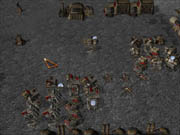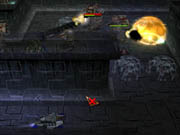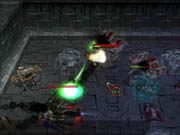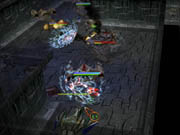The Moon Project is a fully 3D real-time strategy game set in the year 2150. It's actually the sequel to Earth 2150, which was released in the summer of 2000. While it wasn't as popular in the United States as it was in Germany (where it was originally released), Earth 2150 was an excellent game that remained true to real-time strategy conventions but still offered many interesting features, such as the ability to construct original units from component parts. The Moon Project stays very close to this formula and has the same three playable factions as the original game, but it also introduces many improvements to the game's 3D engine, as well as additional weapons and units, and improved enemy artificial intelligence.

The Moon Project was originally intended to be an expansion to Earth 2150, but the developer decided to make it a stand-alone game. Thought the new game is different from its predecessor, The Moon Project does have a lot of superficial similarities to it, and this can make it seem like less than a full-blown sequel. Earth 2150 told the story of three factions: the Eurasian Dynasty, Lunar Corporation, and the United Civilized States. Each of these was trying to acquire enough resources to build an evacuation fleet in time to escape the earth, following a major war that caused the earth to move out of its orbit. Unlike most sequels, The Moon Project actually takes place during the exact same time period as its predecessor. The Lunar Corporation discovers an alien relic buried beneath the moon's surface and begins researching the weapon. The other factions catch wind of this and move in to stop the new threat.
The 3D engine in The Moon Project has been revised to allow for more detail and has been optimized to run more smoothly. The game also focuses on combat and research more than its predecessor does. In Earth 2150's campaign, you had a time limit in which to build an evacuation fleet, but The Moon Project doesn't confine you to these constraints.
While the engine has been improved, the controls and interface remain largely identical to those in Earth 2150. Fans of the previous game will feel right at home, but the game is still pretty easy for new players to pick up and start playing, especially if they're experienced with other real-time strategy games. The Moon Project features easy-to-use camera controls: The right mouse button is used to rotate and elevate the camera, while the mouse wheel is used to zoom in and out. The interface panels are unobtrusive and can be removed, and building lists only appear when a construction unit or facility is selected. The screen can even be split if you want to keep track of different areas at the same time. You can also set the game speed, but speeding up play can make the game's performance suffer on a low-end system. Otherwise, when the action gets intense, the game simply slows down, so as to maintain playability by not compromising the frame rate. This way, you can still coordinate attacks effectively.

The Moon Project looks good, and the effects in the game are impressive. Plasma bolts and laser beams are vividly colored, and you can see energy shields shimmer around the units on the receiving end. Nuclear explosions form huge mushroom clouds that shake the screen violently. The game's 3D engine isn't just for show--the unit detail is high enough that you can tell what weapons are equipped on the various units. This is particularly important because the game lets you construct your own units, so it's good to be able to tell what sort of weapons are mounted on a tank chassis just at a glance. When nighttime falls, you can even turn the lights off on your units either to hide them or to help launch sneak attacks on an enemy. Even more minor details help add to the game's atmosphere--shadows revolve around a building as the day ends and nighttime begins. Trees burst into flame and fall over when hit by errant gunfire.
The sound of the game isn't quite as good, but it's not that bad either. The weapon effects are fairly subdued overall, though explosions sound convincing. On the other hand, the sweeping, orchestral music is done really well, especially the Eurasian Dynasty's tracks. The game has 10 new music tracks in addition to the standard Earth 2150 tracks.
Perhaps the greatest thing about the game is its convincing sense of realism. The maps are representative of actual geographic areas on both the earth and the moon. When units or buildings are destroyed, their charred remains are left on the battlefield. The former buildings actually block a unit's line of site, so that units must maneuver around the rubble in order to get a clear shot at their enemies. Your units can accidentally harm your own buildings if you're not careful: When rockets miss their targets, they continue on their flight path until they explode. The terrain may block shells and rockets from reaching their targets as well. Shields are only effective at blocking energy weapons, so any projectile weapon will penetrate and take away from a unit's health directly.

The Moon Project adds new land, sea, and air units to each faction's already formidable arsenal. Some of these new weapons are available to every side--stationary artillery is one such addition. It has a very long range and can cause massive damage as either an offensive or defensive weapon. Each side can also place earthquake generators on units, which can severely damage buildings. Earthquake generators can be very devious in that they can be used underground to damage buildings above. In addition to these weapons, each side has some new unique units.
Thankfully, The Moon Project has improved the artificial intelligence of your units. While pathfinding and target acquisition were already very good in Earth 2150, the units would continue moving toward a target when attacking, even when they were within weapon range. This led to their getting themselves killed by powerful, short-range weapons like the Lunar Corporation's electro cannon. The worst culprits in Earth 2150 were the aircraft: They would chase enemies into their base and quickly get destroyed in the process. The Moon Project fixes both of these major issues. Units stop at their maximum weapon range when engaging targets. Not only can aircraft hold position and have advanced scripts, but they can also have dynamic attacks. This means that they will swoop in to fire their weapons, continue flying away from the target, then turn around to fire again. It's only really useful when enemies haven't researched heat-seeking rockets.
The game features three single-player campaigns. The United Civilized States campaign starts with your having to rally its disorganized forces on the moon. You must lead your forces to find lost units and to find the main base. The Lunar Corporation must defend its home territory. The Eurasian Dynasty campaign takes place on the earth--you play as an ambitious warrior who tries to gain in rank by gaining career points for each victory you achieve.

The fact that the game was intended to be an add-on does show. There aren't as many missions available as in Earth 2150. Yet it's not a short game, as each side has at least 10 missions, not including nonessential side missions. The missions can be difficult right from the beginning due to your being outnumbered or your being outclassed in technology. Even the first mission starts you off with some of the more advanced weaponry that wasn't even available in Earth 2150 until halfway through the game. Unfortunately, the enemy artificial intelligence can't cope with advanced strategies or weapons. For example, when playing as the UCS, the computer can't get around the shadow technology that cloaks friendly units from sight. So a group with only one shadow unit can decimate a computer's base without it even firing a shot in retaliation. When you get to this point, you will find more enjoyment playing multiplayer games against human players. Multiplayer games can be found on Earthnet, the free matchmaking service provided with the game.
The Moon Project is one of those games that make you wonder why others in the genre don't have the same features. Then again, a real-time strategy game with good graphics, good artificial intelligence, and good unit balance is quite uncommon. But The Moon Project is such a game: The graphics are distinctive, the computer opponent is good enough to give even experienced players a tough time, and each side plays differently and has its own advantages. Fans of the series will be able to dive right into the game and won't be disappointed. New players may even be compelled to get Earth 2150 after their experience with The Moon Project. Regardless, if you're into real-time strategy games, then you'll find that The Moon Project is a rewarding, interesting game that's well worth your while.